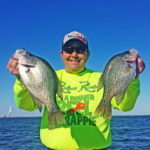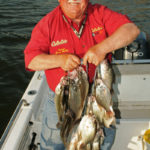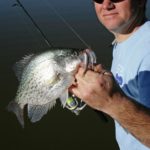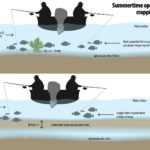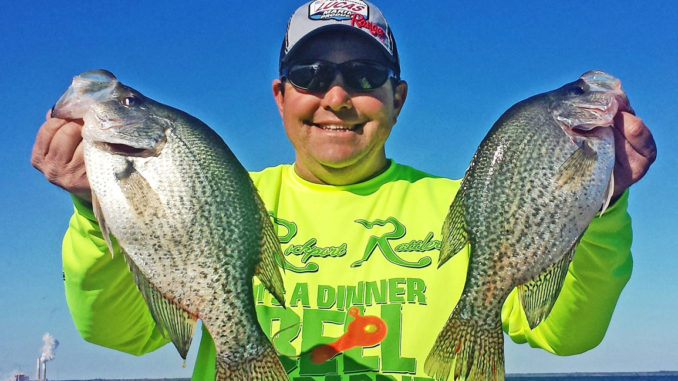
When hot weather arrives, crappie fishing doesn’t have to disappear. These half-dozen destinations keep producing slabs for anglers from both Carolinas.
If you’re looking for a great summer crappie connection in the Carolinas, the good news is most anglers have excellent fishing close by. According to most experts, the basic patterns for summer slabs are to fish deeper water, heavy cover or a combination of both.
These lakes have produced fine hot-weather crappie fishing over a number of years. They’ve distinguished themselves as great places to spend a July day. Pick one, and the tactics you enjoy, and sling some slabs into your cooler.
Kerr Lake
One lake that is among the most-prolific for producing crappie during the summer is Kerr Lake along the North Carolina-Virginia border. Joel Richardson of Kernersville, N.C., who has guided fishermen for more than 20 years, said Kerr, aka Buggs Island, is his No. 1 lake for hot-weather crappie fishing.
“The size of the lake and the diversity of water are key elements for summertime crappie fishing,” he said. “I have three different patterns that work extremely well during the summer.”
Richardson, 48, said the first pattern may be his favorite, but it’s not always the most productive.
“Deep water and man-made brush piles are a dynamite combination for summertime crappie,” he said. “I have put a lot of these in place, but the lake has a tremendous number of these places. The best depth is the 12- to 20-foot range. I prefer to fish these with ultralight spinning rigs with 4-pound test line and light jigs. I’ll set up on a specific spot and cast the jig, count it down and work it right over the brush, since crappie prefer the lure at or just above their depth. It’s crucial to not let the jig fall too deep.”
Richardson (336-803-2195) said that on post-frontal days or just when the bite is slow, he’ll tip the jig with a minnow; that can make a big difference, both in numbers of fish as well as quality.
Go as light as possible
“For all my summertime fishing, I’ll use as light a jig as I can, with a 1/16-ounce being my favorite,” he said. “If the wind is up I’ll use a 1/8- or a maximum of a 3/16-ounce to maintain proper feel.”
A second strong pattern — the one in which the most crappie may be found on some days, is an open-water scenario where crappies suspend in 15 to 20 feet over deeper water. Richardson said crappies will often suspend above an old channel ledge, or they may be relating to open-water forage.
“I catch a lot of crappie (over) open water, and some of the larger fish of the summer,” he said. “I locate them by using my graph, and I still prefer casting jigs. However, it’s also a good setup for live-bait fishermen. My third pattern is bottom bumping a minnow with a tight-line off stumpy points or ledges that drop into much deeper water.”
Richardson said an average July day on Kerr will usually mean 50 to 100 crappie, and occasionally double that number.
“The best part for me is the fishing is consistently productive all summer,” he said.
Lake Moultrie
Lake Moultrie is once again among the premier crappie fisheries in South Carolina. Scott Lamprecht, a fisheries biologist with the S.C. Department of Natural Resources who oversees the Santee Cooper lakes, said the abundant growth of native aquatic vegetation and good spawns in recent years have helped this resurgence.
The key to success at Lake Moultrie is the ability to utilize electronics to find concentrations of crappie — often huge in number — in fairly small spots. Guide Kevin Davis has that down to an art form.
“We’re catching excellent numbers, and even during the summer, plenty of slabs as well,” he said. “But it does require some deep thinking in terms of where the fish are found. I’ll use my graph to find woody cover in the 16- to 35-foot depth range, with cloud cover and windy playing a role in depth; the fish usually suspend shallower on cloudy or windy days. Typically, the brushy cover will rise several feet off the bottom, and the best days are when crappies hold around the edges. If they are holding deep in the cover, they can still be caught, but that requires a more-delicate presentation because of snags.”
Live minnows often work great, but sometimes better with a jig
Davis works minnows vertically, and he’ll use his electric motor to ease live bait just over the top of the brush and around the sides; that’s often all he has to do. He will also use jigs and jigs tipped with minnows.
“Usually, live minnows fished on a tight-line with a small hook work great,” he said. “But some days, a jig and minnow fished the same way will produce bigger fish. I’ll experiment until I hit the right pattern for that day. We’ll catch quality crappie, with some in the 2-pound class, and often limit numbers of fish. We may catch limits from a single spot, but usually we’ll need to work several places to end up with a cooler of crappie.”
Davis said that a number of large, artificial reefs have been placed in Lake Moultrie and the coordinates are on the SCDNR website (www.dnr.sc.gov).
“The public fish attractors produce a lot of crappie during the summer,” he said.
High Rock Lake
High Rock Lake is often an overlooked summertime crappie destination. The fertile lake is not huge, but the 15,000 surface acres offers plenty of opportunity for excellent crappie fishing.
One expert who doesn’t overlook this resource Maynard Edwards of Lexington, N.C., who has operated Yadkin Lakes Guide Service for almost 25 years.
“July produces excellent crappie fishing on High Rock,” Edwards said. “I like the water color of the lake for hot weather fishing and it excels as an open water crappie fishing lake.
“Once the deep-water fishing sets up, it holds through the summer,” he said. “Daily patterns will change, but typically I’ll find crappie in the 18- to 25-foot depth range, but occasionally as deep as 35 feet.”
Edwards’ basic rig is an in-line drop rig, with two-hook loops each with a No. 2 wire hook. He uses a 1-ounce weight on the bottom — it’s worked as a bottom-bumper style rig — but he seldom actually bumps the bottom with it.
Slow troll for suspended crappie
“My technique is a slow troll in open water searching for suspended crappie,” he said. “I’ve found crappie don’t always relate to cover such as brush, stumps or logs. Some do, of course, but I target fish orienting to forage in open water or suspended above underwater features such as ledges or humps.
Edwards (336-249-6782) uses electronics to spot schools of crappie and forage before putting out his baits.
“Crappie will often use underwater features such as ledges as travel routes,” he said. “I search and find them before fishing. We’ll typically catch several quickly, but when the action slows, I’ll move and find another group.
“I’ve learned that an area will likely produce again later in the day with another group of fish moving in. I think crappie move a lot during the summer, and my technique takes advantage of that trait.”
Edwards uses different bait and lure combinations on each trip until he finds the right one. He’ll use live minnows on one of the two hooks on his rig and a tube jig with minnow trailer on the other. In some cases, he will use a minnow on one rig and a curlytail grub on the other.
“I tinker with it until I find the best on a given day,” he said. “I’ve found during the summer the biggest crappie are often caught deep, near the 25-foot depth.”
Lake Murray
Guide Brad Taylor said that by July, the crappie in South Carolina’s Lake Murray are in solid summertime patterns.
“For me, the best pattern will be on the brushpiles in 20 to 25 feet of water,” he said. “Crappie can be found and caught on other types of woody cover, but brush piles are dependable, and now is the time of the year when I expect to catch limits of crappie on most every trip. Even though the fish are deeper, they are predictable, and this consistency is the key.”
Taylor (803-331-1354) said that the fish can be caught with either jigs or minnows, or a combination, depending on time of day or an angler’s skill level.
“Early in the morning and again later in the evening — specifically during low-light conditions — crappie are typically near the top of the brush,” Taylor said. “Casting small, 1/16-ounce jigs around the top of the brush, sometimes as shallow as 12 feet of water, is an ideal way to begin.”
Watch the sun, because the fish do
Later in the day, when the sun gets high, crappie migrate deeper and stage alongside or in the cover.
“That’s when I will typically use live bait,” he said. “I’ll use a 10-foot rod, rigged with 4-pound test line and a No. 2 Aberdeen hook. I use a small split-shot about a foot above the hook, and I prefer to hook the minnow in the tail. Hooking them in the tail enables them to swim better and get better movement to tempt crappie out of the cover. Sometimes, I do fish in brush, but usually, working the edges produces plenty of fish. I’ll mark the cover with a marker buoy after I pinpoint the location with my electronics but I toss the marker to the side, using it as a reference, not on top of the cover.”
Taylor said most of the action will be in the main body of the lake, where the water is slightly cooler,” Taylor said. “From mid-June on through summer, the crappie fishing is excellent, and often we’ll catch limits quickly.”
Lake Norman
Guide Jerry Neeley said North Carolina’s Lake Norman is an interesting hot- weather lake for slabs, with its 32,500-acre size one reason it offers tremendous crappie-producing potential.
“Lake Norman is a big lake with a diversity of summertime crappie fishing opportunities,” he said. “By July, fish are solidly in summer patterns and I have a couple of ‘go-to’ methods for this lake.”
Neeley (704-678-1043) said fishing can be excellent all over the lake, but depths and patterns can change. His bread-and-butter technique is long-line trolling, usually with 10 rods behind his boat, pulling jigs of various colors, usually tipped with a live minnow.
“The main body of the lake is a key for trolling; I look for forage and crappie on my graph before working an area,” he said. “I’m always ready to troll, but the clear water can be problematic if it’s too clear.
Shooting docks is a sure thing during summer
“For me, the most-dependable summertime pattern at Norman is shooting docks,” he said. “Shooting docks is the technique of holding a small jig in one hand, pulling it back and use the tip action of the rod to ‘shoot’ the jig into tight areas.”
Neely uses a 5-foot rod with a fast tip and fast action, coupled with a push-button reel loaded with 4-pound line. He prefers a 1/32-ounce hair jig for this type fishing.
“Best jig colors on Lake Norman will vary, but typically I’ll start with red and white, or yellow, red and white,” he said. “I think the shade and cover around the docks is a key, and I catch more and consistently bigger crappie shooting docks during the summer. Not all docks are created equal, so when I hit a good one, I’ll look for a pattern for similar docks.
Neeley said the key may simply be piers with pilings, floating docks or a combination. Lock into the pattern of the day and catch more fish.
“Most of the time I’ll fish docks in 10 to 12 feet of water, but in low light maybe a little shallower,” he said.
Lake Wateree
Lake Wateree is a prime but often under-utilized crappie destination during the summer. It produces plenty of slabs, even during hot weather, and catching limits of quality fish is not unusual.
Ken Boone is a 76-year-old crappie guru who lives on Wateree and typically multiple times a week.
“After 70-plus years of fishing here, I’ve still got crappie-fishing fever,” Boone said. “In recent years, Lake Wateree has been on fire for crappie fishing, as good as I’ve seen in a long time for size and quality of fish. We’ve had good spawns, still have a great forage base and catch a lot of crappie throughout the summer.
Boone primarily casts 1/32-ounce jigs on 4-pound test line around brush, logs and any cover he spots using his graph in 12 to 20 feet of water.
Low end of lake has hot action
“I like the mid-part of the lake around June, and Singleton Creek best, because I live close to that area,” he said. “But the action is good on the lower end, from Colonels Creek to the dam. It’s just further for me to go.
“My technique is simple, I’ll cast the jig and count it down to the cover I’m fishing and reel it very slowly,” Boone said. “If I don’t get bites quickly, I’ll move to another spot. With the graph recorders and side-scan capability, anglers can find plenty of places. Usually when I find fish, I’ll be able to catch several from one spot.”
Boone said that anglers will have good success tight-lining minnows over these type areas.
“Live bait will catch plenty of crappie, but the key is to be mobile with either technique if you’re not catching fish,” he said. “If I’m catching fish, I’ll stay even if the fishing in not real fast-paced. But once I work a spot out and don’t get any fish it’s time to move on whether you use jigs or live bait.”
Click here for a video about catching crappie two at a time.

